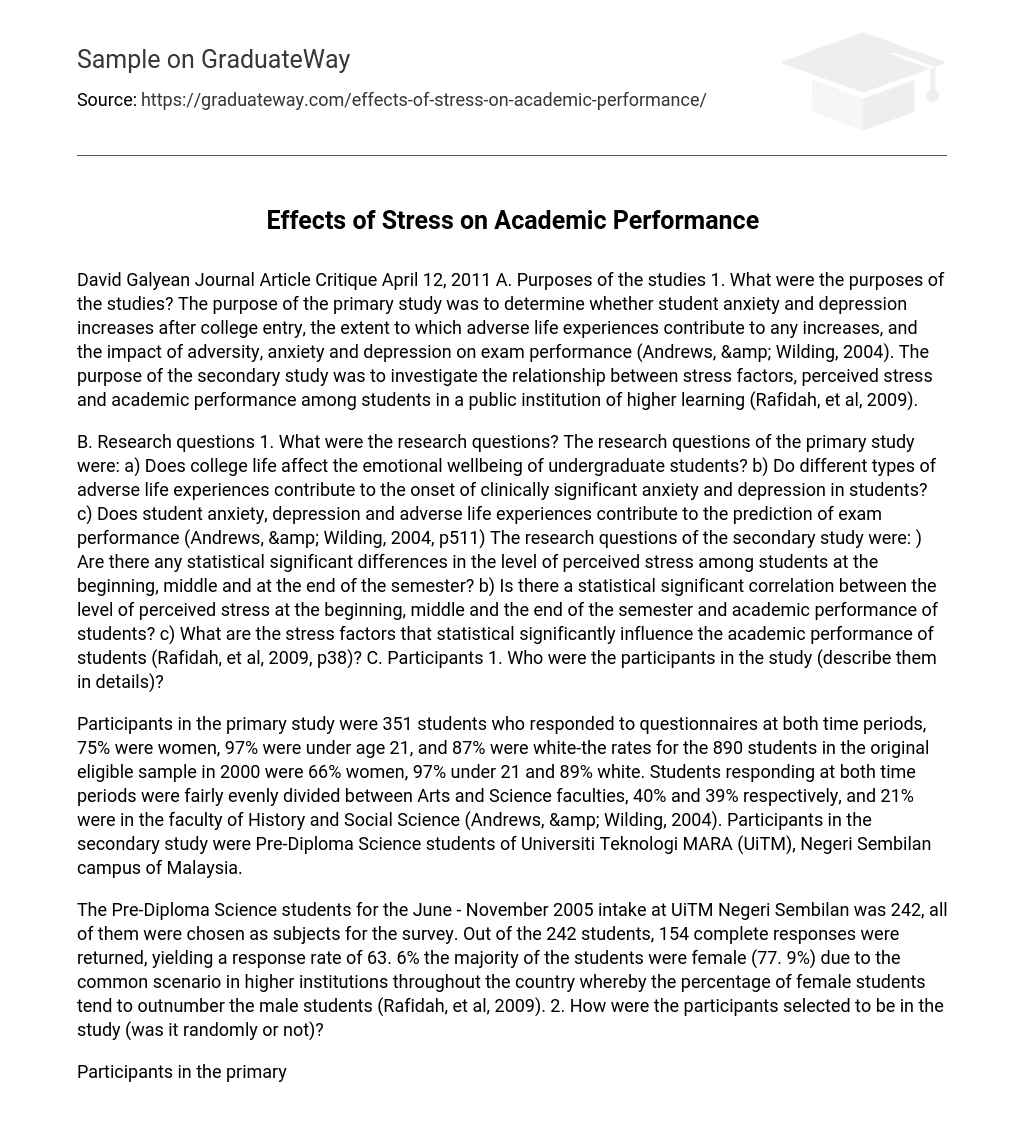Purposes of the studies
What were the purposes of the studies?
The purpose of the primary study was to determine whether student anxiety and depression increases after college entry, the extent to which adverse life experiences contribute to any increases, and the impact of adversity, anxiety and depression on exam performance (Andrews, & Wilding, 2004). The purpose of the secondary study was to investigate the relationship between stress factors, perceived stress and academic performance among students in a public institution of higher learning (Rafidah, et al, 2009).
Research questions
What were the research questions? The research questions of the primary study were:
- Does college life affect the emotional wellbeing of undergraduate students?
- Do different types of adverse life experiences contribute to the onset of clinically significant anxiety and depression in students?
- Does student anxiety, depression and adverse life experiences contribute to the prediction of exam performance (Andrews, & Wilding, 2004, p511)
The research questions of the secondary study were:
- Are there any statistical significant differences in the level of perceived stress among students at the beginning, middle and at the end of the semester?
- Is there a statistical significant correlation between the level of perceived stress at the beginning, middle and the end of the semester and academic performance of students?
- What are the stress factors that statistical significantly influence the academic performance of students (Rafidah, et al, 2009, p38)
Participants
Who were the participants in the study (describe them in details)?
Participants in the primary study were 351 students who responded to questionnaires at both time periods, 75% were women, 97% were under age 21, and 87% were white-the rates for the 890 students in the original eligible sample in 2000 were 66% women, 97% under 21 and 89% white. Students responding at both time periods were fairly evenly divided between Arts and Science faculties, 40% and 39% respectively, and 21% were in the faculty of History and Social Science (Andrews, & Wilding, 2004). Participants in the secondary study were Pre-Diploma Science students of Universiti Teknologi MARA (UiTM), Negeri Sembilan campus of Malaysia.
The Pre-Diploma Science students for the June – November 2005 intake at UiTM Negeri Sembilan was 242, all of them were chosen as subjects for the survey. Out of the 242 students, 154 complete responses were returned, yielding a response rate of 63. 6% the majority of the students were female (77. 9%) due to the common scenario in higher institutions throughout the country whereby the percentage of female students tend to outnumber the male students (Rafidah, et al, 2009).
How were the participants selected to be in the study (was it randomly or not)?
Participants in the primary study were not randomly selected; all UK domiciled students who had a place confirmed on a full-time undergraduate degree course by the end of August 2000 were mailed a questionnaire and information sheet with a reply-paid envelope to their home address (Andrews, & Wilding, 2004). Participants in the secondary study were not randomly selected; the number of pre-diploma Science students for the June – November 2005 intake at UiTM Negeri Sembilan was 242, all were chosen as subjects for the survey (Rafidah, et al, 2009).
Data collection
What instruments (e. . test, questionnaire, survey) were used to collect the data?
In the primary study the students completed the Hospital Anxiety and Depression Scale (HADS) both pre-entry and mid-course. Areas of adversity were assessed in the mid-course survey only. From a list of 11 experiences, students were asked to indicate separately for the first and current (second) academic year whether any had happened to them. Items relevant to students were modified from the List of Threatening Experiences which is composed of experiences with a high probability of having moderate or marked long-term threat.
The study used t tests for group comparisons of continuous variables, and chi-squared tests (with Yates’ correction) for dichotomous variables. Logistic regression analysis was used to determine the relative contribution of significant variables to the prediction of depressive and anxiety conditions mid-course. Multiple regression analysis was used to determine the relative contribution of significant variables to 2nd year exam averages. In all the multivariate analyses, gender, age (over 21 or not) and ethnicity (white or not) were entered as control variables (Andrews, & Wilding, 2004).
In the secondary study a structured, self-administered questionnaire was developed as a mode of data collection. The questionnaire comprised of three sections, students’ profile; Perceived Stress Scale (PSS); and Stress Factors Survey (Rafidah, et al, 2009).
How were the participants protected?
In the primary study ethical permission was obtained from the University and students were fully briefed about the research with assurance of anonymity and confidentiality (Andrews, & Wilding, 2004). There is no evidence in the secondary study that the participants were protected in any way. The study does not reference permissions or consent of any kind (Rafidah, et al, 2009).
What did the researchers find?
Participants in the primary study indicated a significant increase in both HADS anxiety and depression means from before entry to mid-course, t(348) of 3-35, p < . 001, and 6. 1, p < . 001, respectively. Among students with no significant depression or anxiety symptoms before entry, a relatively small proportion (9%) developed a mild or clinically significant depressive condition by mid-course; onset of case anxiety without any significant depressive element was more common (20%).
Conversely it is notable that just under a third of students with mild or case depression before entry were relatively symptom free by mid-course. A similar picture is also apparent for those with prior case anxiety without depression-by mid-course over a third were relatively symptom-free.





